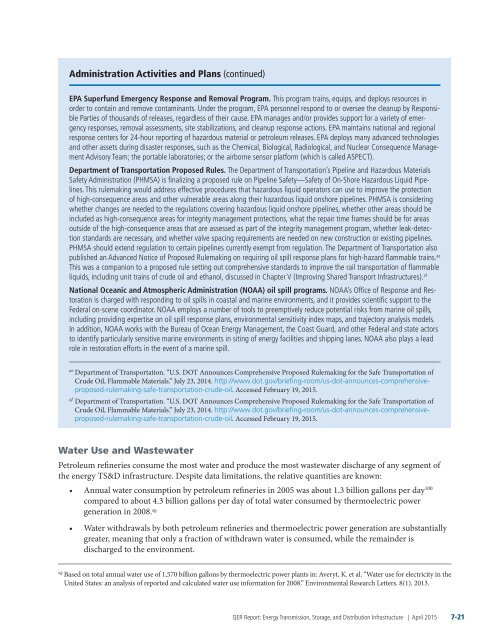LVXXU
LVXXU
LVXXU
You also want an ePaper? Increase the reach of your titles
YUMPU automatically turns print PDFs into web optimized ePapers that Google loves.
Administration Activities and Plans (continued)<br />
EPA Superfund Emergency Response and Removal Program. This program trains, equips, and deploys resources in<br />
order to contain and remove contaminants. Under the program, EPA personnel respond to or oversee the cleanup by Responsible<br />
Parties of thousands of releases, regardless of their cause. EPA manages and/or provides support for a variety of emergency<br />
responses, removal assessments, site stabilizations, and cleanup response actions. EPA maintains national and regional<br />
response centers for 24-hour reporting of hazardous material or petroleum releases. EPA deploys many advanced technologies<br />
and other assets during disaster responses, such as the Chemical, Biological, Radiological, and Nuclear Consequence Management<br />
Advisory Team; the portable laboratories; or the airborne sensor platform (which is called ASPECT).<br />
Department of Transportation Proposed Rules. The Department of Transportation’s Pipeline and Hazardous Materials<br />
Safety Administration (PHMSA) is finalizing a proposed rule on Pipeline Safety—Safety of On-Shore Hazardous Liquid Pipelines.<br />
This rulemaking would address effective procedures that hazardous liquid operators can use to improve the protection<br />
of high-consequence areas and other vulnerable areas along their hazardous liquid onshore pipelines. PHMSA is considering<br />
whether changes are needed to the regulations covering hazardous liquid onshore pipelines, whether other areas should be<br />
included as high-consequence areas for integrity management protections, what the repair time frames should be for areas<br />
outside of the high-consequence areas that are assessed as part of the integrity management program, whether leak-detection<br />
standards are necessary, and whether valve spacing requirements are needed on new construction or existing pipelines.<br />
PHMSA should extend regulation to certain pipelines currently exempt from regulation. The Department of Transportation also<br />
published an Advanced Notice of Proposed Rulemaking on requiring oil spill response plans for high-hazard flammable trains. ae<br />
This was a companion to a proposed rule setting out comprehensive standards to improve the rail transportation of flammable<br />
liquids, including unit trains of crude oil and ethanol, discussed in Chapter V (Improving Shared Transport Infrastructures). af<br />
National Oceanic and Atmospheric Administration (NOAA) oil spill programs. NOAA’s Office of Response and Restoration<br />
is charged with responding to oil spills in coastal and marine environments, and it provides scientific support to the<br />
Federal on-scene coordinator. NOAA employs a number of tools to preemptively reduce potential risks from marine oil spills,<br />
including providing expertise on oil spill response plans, environmental sensitivity index maps, and trajectory analysis models.<br />
In addition, NOAA works with the Bureau of Ocean Energy Management, the Coast Guard, and other Federal and state actors<br />
to identify particularly sensitive marine environments in siting of energy facilities and shipping lanes. NOAA also plays a lead<br />
role in restoration efforts in the event of a marine spill.<br />
ae<br />
Department of Transportation. “U.S. DOT Announces Comprehensive Proposed Rulemaking for the Safe Transportation of<br />
Crude Oil, Flammable Materials.” July 23, 2014. http://www.dot.gov/briefing-room/us-dot-announces-comprehensiveproposed-rulemaking-safe-transportation-crude-oil.<br />
Accessed February 19, 2015.<br />
af<br />
Department of Transportation. “U.S. DOT Announces Comprehensive Proposed Rulemaking for the Safe Transportation of<br />
Crude Oil, Flammable Materials.” July 23, 2014. http://www.dot.gov/briefing-room/us-dot-announces-comprehensiveproposed-rulemaking-safe-transportation-crude-oil.<br />
Accessed February 19, 2015.<br />
Water Use and Wastewater<br />
Petroleum refineries consume the most water and produce the most wastewater discharge of any segment of<br />
the energy TS&D infrastructure. Despite data limitations, the relative quantities are known:<br />
• Annual water consumption by petroleum refineries in 2005 was about 1.3 billion gallons per day 100<br />
compared to about 4.3 billion gallons per day of total water consumed by thermoelectric power<br />
generation in 2008. ag<br />
• Water withdrawals by both petroleum refineries and thermoelectric power generation are substantially<br />
greater, meaning that only a fraction of withdrawn water is consumed, while the remainder is<br />
discharged to the environment.<br />
ag<br />
Based on total annual water use of 1,570 billion gallons by thermoelectric power plants in: Averyt, K. et al. “Water use for electricity in the<br />
United States: an analysis of reported and calculated water use information for 2008.” Environmental Research Letters. 8(1). 2013.<br />
QER Report: Energy Transmission, Storage, and Distribution Infrastructure | April 2015 7-21


